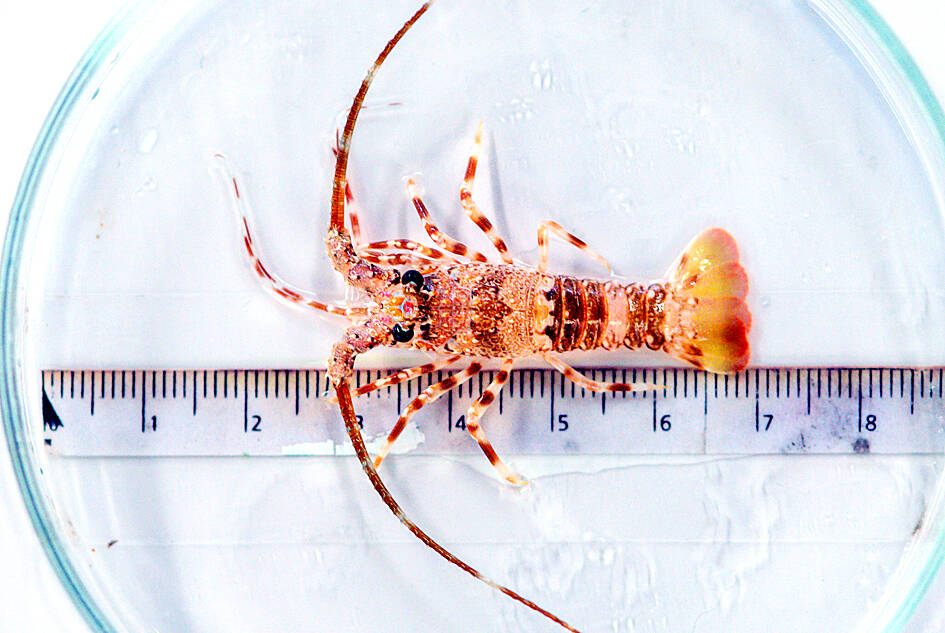Taiwanese aquaculture researchers have raised the survival rate of lobster hatchlings from 40 percent to 70 percent, the Council of Agriculture’s Taitung District Agricultural Research and Extension Station said.
The station unveiled the breakthrough at a trade convention in November last year.
Lobster spawns molt several times in the six months following hatching to reach the postlarvae stage, said Cheng Ming-chung (鄭明忠), an assistant researcher with the Fisheries Research Institute’s Eastern Marine Biology Research Center.

Photo courtesy of Cheng Ming-chung
Postlarvae are highly sensitive to water quality and fluctuations in environmental factors, and regularly engage in cannibalism, which makes keeping them alive a technical challenge for lobster farms, said Cheng, who led the project to improve lobster farming techniques.
Taiwanese lobster farms typically import 2cm-long postlarvae harvested from the sea and raise them into 4cm-long juveniles, he said.
The research team solved the issue of cannibalism by introducing shrimp larvae into the pool for the postlarvae to hunt, while large clumps of kelp provided hiding places, he said, adding that new technologies were used to improve the regulation of water and feed quality.
The techniques could help farmers raise more lobsters from the same larvae stock, and improve the flavor of the tomalley and the firmness of the meat, Cheng said.
The researchers used the species Panulirus homarus and Panulirus ornatus in the study, with the former being the more readily available and economic option for Taiwanese lobster farms, he said.
Using the new methods, the Panulirus homarus could grow from 2cm-long prolarvae to 4cm-5cm juveniles in two months, Cheng said, adding that the juveniles could then be transferred to downstream farms specializing in growing adults.
Juveniles can grow into market-ready adults weighing 250g to 300g in eight months, he added.
The Council of Agriculture has unveiled a policy to encourage the use of solar panels on lobster farms with indoor pools, to ensure a stable power supply and water salinity levels at the farms, center director Ho Yuan-hsing (何源興) said.
Open-air lobster farms are prone to drops in water salinity due to power outages or human error, which could lead to larvae deaths, he said, adding that lobsters are nocturnal animals and thrive in roofed pools.
Improved aquafarming techniques can reduce the nation’s reliance on imports and the impact of lobster fishing on nature, he said.
Representatives from the solar energy and aquafarming sectors have expressed an interest in working together, he added.

US climber Alex Honnold is to attempt to scale Taipei 101 without a rope and harness in a live Netflix special on Jan. 24, the streaming platform announced on Wednesday. Accounting for the time difference, the two-hour broadcast of Honnold’s climb, called Skyscraper Live, is to air on Jan. 23 in the US, Netflix said in a statement. Honnold, 40, was the first person ever to free solo climb the 900m El Capitan rock formation in Yosemite National Park — a feat that was recorded and later made into the 2018 documentary film Free Solo. Netflix previewed Skyscraper Live in October, after videos

Starting on Jan. 1, YouBike riders must have insurance to use the service, and a six-month trial of NT$5 coupons under certain conditions would be implemented to balance bike shortages, a joint statement from transportation departments across Taipei, New Taipei City and Taoyuan announced yesterday. The rental bike system operator said that coupons would be offered to riders to rent bikes from full stations, for riders who take out an electric-assisted bike from a full station, and for riders who return a bike to an empty station. All riders with YouBike accounts are automatically eligible for the program, and each membership account

A classified Pentagon-produced, multiyear assessment — the Overmatch brief — highlighted unreported Chinese capabilities to destroy US military assets and identified US supply chain choke points, painting a disturbing picture of waning US military might, a New York Times editorial published on Monday said. US Secretary of Defense Pete Hegseth’s comments in November last year that “we lose every time” in Pentagon-conducted war games pitting the US against China further highlighted the uncertainty about the US’ capability to intervene in the event of a Chinese invasion of Taiwan. “It shows the Pentagon’s overreliance on expensive, vulnerable weapons as adversaries field cheap, technologically

NUMBERs IMBALANCE: More than 4 million Taiwanese have visited China this year, while only about half a million Chinese have visited here Beijing has yet to respond to Taiwan’s requests for negotiation over matters related to the recovery of cross-strait tourism, the Tourism Administration said yesterday. Taiwan’s tourism authority issued the statement after Chinese-language daily the China Times reported yesterday that the government’s policy of banning group tours to China does not stop Taiwanese from visiting the country. As of October, more than 4.2 million had traveled to China this year, exceeding last year. Beijing estimated the number of Taiwanese tourists in China could reach 4.5 million this year. By contrast, only 500,000 Chinese tourists are expected in Taiwan, the report said. The report